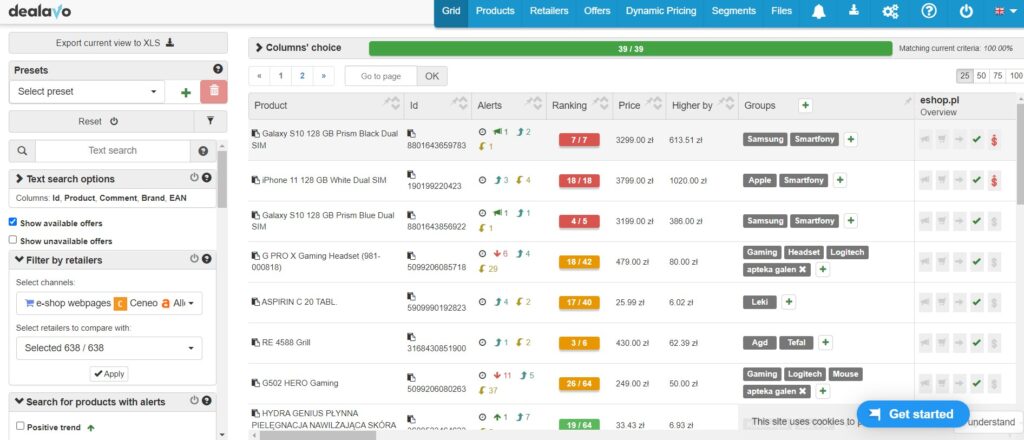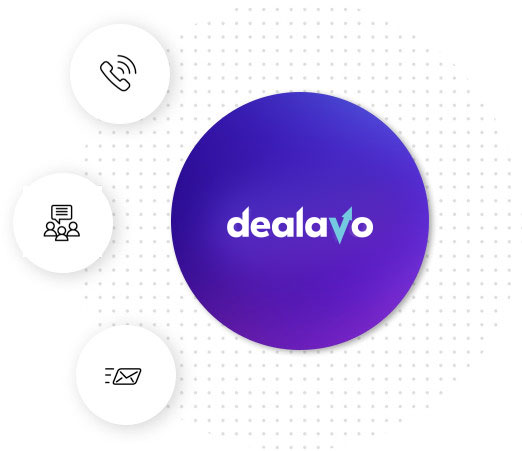Digital Shelf – management, optimisation, strategy, examples
- 22 January 2024
Just like shelves in physical stores enable shoppers to get acquainted with the given product, digital shelf in e-commerce is an online environment where online stores can present their products. Nowadays, the importance of this aspect of online trade is enormous, primarily due to huge competition. What do you need to consider when designing a digital shelf management strategy?
Imagine you walk into a physical store. There are aisles with products stacked on both sides of each aisle. You approach the product you’re interested in. You take a look at it, grab it from the shelf, check the price, and some basic parameters that can be listed on the box or near the price tag. Finally, you make the decision to put this product in your cart and go to the cashier or self-service checkout.
This is how it usually works in the offline world. And the truth is that when it comes to the digital shelf in e-commerce, things are very similar! First, the customer enters the store – this can be your online store’s website or your profile in one of the marketplaces (perhaps eBay or Amazon). They next try to locate a specific product. When they do, they enter the digital shelf section – a place online where your product is displayed for potential customers.
Digital shelf management: Elements you need to consider
There are six basic elements of the digital shelf:
- Product information: Here, we have product descriptions, technical specifications and parameters, and other relevant information (e.g., who a given product is intended for).
- Pricing information: This aspect revolves around everything relating to the product’s price – how much the product costs, whether it is discounted, and what payment options are available.
- Product images: You need to make sure your product is showcased using high-quality images and videos that show the product from different angles as well as emphasize all the crucial features.
- Product reviews: Displaying customer reviews and product ratings will help you build trust and credibility among potential buyers. This is so-called social proof and one of the key elements of every good offer.
- Inventory data: you also need to provide buyers with information regarding product availability and current stock levels.
- SEO: Lastly, digital shelf optimization is also about making your product tabs and product descriptions SEO-friendly.
Your role as an online store owner is to make sure there is a specific digital shelf optimization process in place that will enable you to showcase your products in the best possible way and attract many customers to your e-store.
Why is digital shelf optimisation so important?
Primarily because e-commerce is now a hugely competitive environment. There are hundreds of thousands of stores out there offering tens of millions of products. Only if you can cut through the noise can you stand out with your offer and attract potential customers.
There are four essential elements that digital shelf analytics and optimization will help you with:
- Better offer visibility: Digital shelf in e-commerce is all about promoting your store’s offer. Thanks to SEO and other marketing strategies, you can direct potential customers to your store, and good digital shelf management strategy will help you convert them into customers.
- Improved customer experience (CX): A well-organized and informative digital shelf provides a better online shopping experience for customers because they have easy access to detailed product information, high-quality images, and customer reviews. In other words, they have everything they need to make an informed decision.
- Competitive advantage: Nowadays, only stores that have all the important aspects of their offer perfected can win the battle for customers’ attention. Well-optimized digital shelves will help you outrun your competitors.
- Brand consistency: Lastly, with good digital shelves, you can make sure your store’s brand is presented exactly the way you want, in a positive and consistent manner. And the truth is your digital shelf strategy (e.g., the way you photograph your products) can help you position your store/brand in a specific way.
Take a look at the study published by Jungle Scout:

Six elements mentioned in this study (including two of the most important ones) can be improved through a good digital shelf strategy. Taking care of this aspect of e-commerce can help you get many new customers and win their loyalty.
Digital shelf analytics
Digital shelf analytics is all about combining all the aforementioned elements and verifying how they are doing vs. your company’s KPIs. Let’s have a look at what you ought to analyze when it comes to different elements of your digital shelf:
- Product descriptions: Your product tabs should contain no empty content fields, and product content (e.g., parameters, images, videos, etc.) should be similar or better compared to your competitors.
- Product prices: Are all the products properly priced (compare competitors’ data). Are we discounting the right products? Are our promotions and sales effective?
- Product availability: Remove all the products that are not in stock from visibility. Check if all the products in your current offer have at least one unit in stock. Consider adding the low stock level warning on your website.
- Product reviews: Do all our products have at least 4/5 reviews? Are these reviews exhausting and attractive to potential buyers?
- SEO: Are all our product descriptions SEO-friendly? Are we running ongoing SEO activities for our store?
You can also add data coming from other sources, e.g., Google Analytics into the mix to get a more holistic view of what’s going on with your digital shelves. A session recording tool such as Microsoft Clarity is also a good idea – it will help you understand better how people interact with your product tabs.

How can you make the most of the digital shelf strategy
There are several aspects of your digital shelf strategy that will allow you to get ahead. Let’s have a look at them:
- Place the products smartly on your website: For example, you should put your best sellers or products that give you the highest profit margin on the top of your main page or search results.
- Make the most of SEO and SEM: Continually implement SEO and Google Shopping Ads strategy that will allow you to boost organic search and position your products in Google Shopping.
- Product descriptions: Make sure your titles have appropriate keywords and that products have exhaustive descriptions and length. Add only high-quality images and videos. Personalize your web copy and adjust it to your target audience’s needs.
- Organize discounts and sales, but don’t overdo them. Use them to attract more customers and increase AOV.
- Make sure your products have reviews and ratings: Positive reviews can encourage consumers to buy something from you. Implement an automated reminder system that asks customers to leave a review shortly after they receive the product.
- Use pricing software to check whether your prices are competitive. If they’re not, consider lowering them to a more attractive level.

Use the right digital shelf software
In theory, you can take care of your digital shelf analytics and optimization on your own. However, such an approach is not necessarily effective, as it will take a lot of time and manual analysis. You can use digital shelf software that will help you organize everything in the best possible manner. We have a list of three tools you can use to achieve this goal:
DEALAVO
Dealavo platform comes with a wide range of tools to improve your online offer. For instance, our price monitoring tools will provide you with information on who offers the same/similar products and for what price. And our Competitor’s Assortment Report enables you to find out what products are missing in your product assortment and what you can do to improve the way your products are showcased and promoted.

SALSIFY
It’s a PXM platform (product experience management) that allows you to centralize all product content and data in one place and adjust it to different sales channels (your website, marketplaces, social media). Salsify also comes with some automation features allowing you to save a lot of time managing and updating product information.

EDGE BY ASCENTIAL
It’s another online tool to measure and benchmark your online retail presence, especially concerning your product information. Edge by Acential is part of the larger e-commerce management platform – Flywheel.

Digital shelf examples
Now, let’s have a look at the example of the Walmart’s online store:

Why is this digital shelf good? For starters, the product tab provides comprehensive and accurate information. This includes detailed specifications, features, and compatibility information. The product descriptions are written in clear and customer-friendly language. Each product is accompanied by high-resolution images showcasing the product from various angles and showing its functionality.
Moreover, the product pages display customer reviews and ratings. There is also clear information that this is a bestseller product that’s currently on sale (Walmart actively uses sales and discounts to drive more customers to their website). Additionally, the Walmart’s website has an intuitive and user-friendly interface. Customers can easily navigate through different categories, use filters to narrow down their choices, and find relevant information without unnecessary clicks.
Lastly, there is clear information on the product’s availability and delivery options. All this makes this digital shelf an effective sales tool.
Trends in digital shelf management to watch
What can we expect in the near future? For one thing, digital shelves will increasingly leverage artificial intelligence to provide highly personalized product recommendations based on individual preferences, purchase history, and real-time contextual data.
In the near future, more stores will adopt dynamic pricing to make the most of real-time market trends, competitor pricing, and individual customer behaviors. This strategy will help you optimize revenue from your online store.
And lastly, digital shelves are likely to be more integrated with social media, thus allowing users to discover and purchase products directly in this channel. Social commerce features such as shoppable posts and live shopping events will become more popular in the e-commerce world.
Wrapping up
Here’s a quick recap of this article:
- Digital shelf is a term relating to how (and where) you showcase your products.
- It encompasses such questions as product descriptions, product photos, pricing data, inventory data, reviews, and SEO.
- You need to constantly work on your digital shelf strategy and optimize all the product-related elements to keep your customers engaged.
- You can streamline your work by using various digital shelf software such as Dealavo.
And how do you take care of your digital shelf? We’d love to read your thoughts. And if you know someone who might use this knowledge, feel free to share this post!




